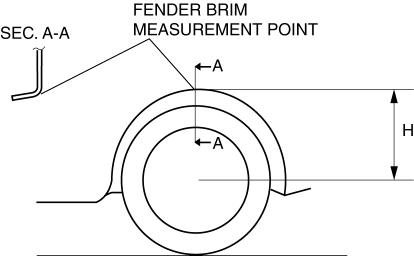Mazda CX-5 Service & Repair Manual: Wheel Alignment Pre Inspection
1. Park the vehicle on level ground, in an unloaded condition*, with the wheels straight forward.
*: Unloaded condition.....Fuel tank is full. Engine coolant and engine oil are at specified level. Spare tire, jack and tools are in designated position.
2. Inspect the tire pressure.
-
Adjust to the recommended pressure if necessary..
3. Inspect the wheel bearing play.
-
Correct if necessary..
4. Inspect the wheel runout.
-
Correct if necessary..
5. Rock the vehicle, and verify that there is no looseness in the steering wheel joint and suspension ball joint.
6. Rock the vehicle, and verify that the shock absorber operates properly.
7. Measure height H from the center of the wheel to the fender brim.

8. Verify that the difference between the left and right dimension H is within the specification.
-
If it exceeds the specification, repeat the Step 2—7.
-
Standard specification
-
10 mm {0.39 in} or less
 Wheels, Tires
Wheels, Tires
...
 Wheel Apron Component Installation [Panel Replacement]
Wheel Apron Component Installation [Panel Replacement]
Symbol Mark
Installation Procedure
1. When installing new parts, measure and adjust the body as necessary to conform
with standard dimensions.
2. Drill holes for the plug welding before inst ...
Other materials:
Purge Control
Outline
An appropriate amount of evaporative gas is fed into the intake manifold
by the purge solenoid valve operation according to the engine operation conditions.
This ensures driveability and prevents release of evaporative gas into the atmosphere.
The PCM drives the purge so ...
A/C Unit
Outline
The A/C unit which integrates the cooling and heater units has been adopted.
Construction
The A/C unit consists of the following parts.
Operation
Air Mix Door Operation
The air mix door, installed in the A/C unit, controls HOT or COLD position,
depend ...
Cruise Control System
Outline
Enables driving at a constant speed by setting the vehicle speed with the
cruise control switch instead of operating the accelerator pedal.
The PCM controls the throttle valve actuator to maintain the vehicle at a
constant speed.
Component and function
...
